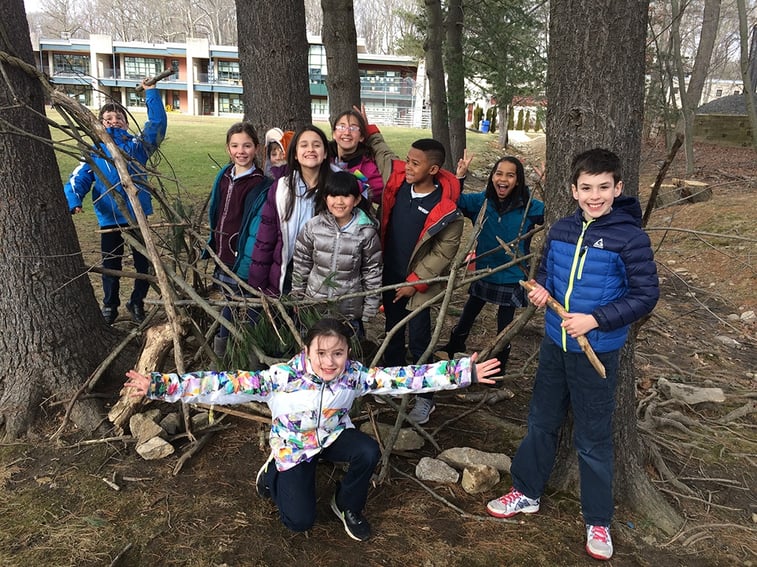“Is it okay if we build a fort?”
It was recess time, and the third graders in our class were begging to build a fort at the edge of the soccer field, against one of the tall trees. Normally, we ask the students to play closer to the playground so we can see them better. Against my better judgment, I told them it was okay. I decided to walk over to be near them as they built their fort to help with any disagreements or the occasional flailing branch.
Watching the students at work, I was surprised. Almost every student in the class had joined the fort building. One child had been cranky that morning; now he was happily gathering branches and random pine cones. Another student who had been having trouble finding a friend to play with was now planning design elements for a wall with another child. All the children had to collaborate to bring their fort to life. They discussed the pros and cons of design ideas. A natural division of labor emerged, with some kids in search of large rocks for the base, and others on a hunt for good branches for the door and roof. When the wind knocked over one “wall,” another little group decided to make cement out of mud to reinforce the base.
Simply put, being in nature increases happiness.

My co-teacher and I constantly try to design collaborative group projects in our classroom, and they usually falter for one reason or another. But here, students had a self-directed, efficient, collaborative effort, where everyone was involved. Everyone was proud. More importantly, everyone was happy.
When we went back inside, the students asked for a picture of the fort. Two students asked me to email the photo to their moms. Another student came to me privately to say thank you for the chance to build the fort. Two others came in chattering about re-design plans to try during the next recess.
All these observations coincide with much of the current research about outdoor education as found in The Dirt Cure by Maya Shetreat-Klein, M.D. Simply put, being in nature increases happiness. Exposure to soil organisms has been shown to improve cognition. Studies show that students score better on standardized tests when they have access to green spaces. Nature enhances healing, reduces pain and anxiety, and increases focus. In addition, lack of time outside is thought to be causing an increase in nearsightedness in children, due to less exposure to natural light.
But I know from my own experiences that increasing outdoor learning experiences can feel daunting. Will the lesson just be a free-for-all? How will I cover all the curriculum I need to be teaching if we are going outside? Won’t kids get messy? What if it's too cold or too hot? I felt like I was opening a can of worms when I simply went to supervise fort building during a short recess time, so I know the obstacle it can seem for teachers and parents to use the outdoors for lesson opportunities. However, there are small steps teachers and parents can take to build in more opportunities for outdoor education.
Here are 9 ways to think about outdoor education opportunities, ideas that can be used at school or at home (ideas inspired by Schoolyard Habitat program at Audubon Greenwich).
1. Take a ten-minute walk around campus (or at home), but give the walk a focus. Ask children to look carefully for something red, for a tree with shaggy or smooth bark, examples of animals using a tree as a home, etc. The focus would change, of course, depending on the time of year. You can expand this by having a nature Bingo page set up, with different items in nature to locate in each box on the page.
2. Think of math or science lessons that may connect to outside. If you are studying systems, maybe do a lesson outside to have the students observe a system in nature. Another idea, if studying structures, is to analyze how organisms they see are suited, designed, and structured to increase likelihood of their survival in this area.
3. Work with students to create a miniature field guide for your school campus or yard at home. Practice having students identify a few trees and native plants and animals.
4. Do a study of native animals, trees, and plants. See if the children can identify any on campus, or at home. If there are none, have the children brainstorm ways to bring native species back to an area.
5. Have students “adopt a tree”. Then, use a field guide to identify the tree. This could lead to questions, such as “what animals use this tree? How does this tree help our area? Do people use this tree?” Encourage students to sketch or take pictures of the tree at different times throughout the year to study its changes.
6. Look for native birds, animals, flowers, and plants. Encourage your child to try to Georgia O’Keeffe style painting or drawing of a native species.
7. Participate in Outdoor Classroom Day on May 18th.
8. Look for other ideas in books such as Vitamin N by Richard Louv, or look at more current research about outdoor education at the Children and Nature Network.
9. Sit outside to listen to a story or do some sketching.
Have your own ideas for outdoor education? Be sure to share them in the comments section below.


